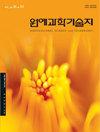Pre-Harvest Oxalic Acid Application Improves Fruit Size at Harvest, Physico-Chemical and Sensory Attributes of ‘Red Flesh’ Apricot During Fruit Ripening
IF 0.8
4区 农林科学
Q3 HORTICULTURE
引用次数: 2
Abstract
Apricot is a highly nutritive stone fruit which ripens quickly after harvest and exhibits rapid fruit quality deterioration at ambient conditions. The current research work was executed to evaluate the effect of pre-harvest application of oxalic acid (OA); (0, 0.5, 1, and 2mM) on fruit quality of ‘Red Flesh’ apricot during fruit ripening at shelf under ambient conditions (25±1 °C; 60-65% RH). Fruit size, average fruit weight, fruit juice percentage was determined at harvest. While, fruit weight loss, fruit colour, fruit firmness, titratable acidity (TA), soluble solid contents (SSC), ratio of SSC to TA, ascorbic acid, total phenolics content (TPC), anti-oxidative scavenging activity (ASA), superoxide dismutase (SOD), peroxidase (POD), catalase (CAT) enzymes activity were determined during fruit ripening. Fruit sensory attributes (fruit pulp colour, fruit taste, fruit flavour and overall acceptability were determined at fruit ripening. Pre-harvest application of 2mM-OA was found the most effective in improving fruit size, average fruit weight, juice percentage at harvest, about 5%, 6% and 15% higher than control, respectively. Additionally, pre-harvest application of 2mM-OA retained higher fruit firmness, ascorbic acid, TPC, ASA and activities of POD, CAT enzymes in apricot fruit during fruit ripening at ambient conditions. On day-5 of fruit ripening 2mM-OA-treated apricot fruit exhibited about 28%, 20%, 17%, 7%, 9% and 23% higher fruit firmness, ascorbic acid, TPC, ASA and activities of POD, CAT enzymes, respectively as compared to control. Moreover, significant lower fruit weight loss (35%), SSC (20%) and SSC:TA ratio (30%) were exhibited by the apricot fruit treated with 2mM-OA than unsprayed apricot fruit. However, fruit treated with 1 mM-OA exhibited better fruit sensory attributes compared to other treatments at fruit ripening. Conclusively, pre-harvest application of 2 mM-OA improved the fruit size, delayed fruit ripening, and retained higher fruit antioxidants of apricot at ambient conditions.采前施用草酸可改善“红肉”杏果实成熟时的大小、理化和感官特性
杏是一种营养丰富的核果,收获后成熟迅速,在环境条件下果实品质迅速恶化。本研究旨在评价收获前施用草酸(OA)的效果;(0、0.5、1和2mM)对“红肉”杏在货架上成熟过程中果实品质的影响;60 - 65% RH)。在收获时测定果实大小、平均果实重量、果汁百分比。测定果实失重、果实颜色、果实硬度、可滴定酸度(TA)、可溶性固形物含量(SSC)、SSC / TA比值、抗坏血酸、总酚类物质含量(TPC)、抗氧化清除活性(ASA)、超氧化物歧化酶(SOD)、过氧化物酶(POD)、过氧化氢酶(CAT)活性。水果的感官属性(果肉颜色、水果味道、水果风味和整体可接受性)在水果成熟时被确定。采前施用2mM-OA对提高果实大小、平均果重和收获时的出汁率最有效,分别比对照提高5%、6%和15%左右。此外,采前施用2mM-OA在环境条件下保持了杏果成熟过程中较高的果实硬度、抗坏血酸、TPC、ASA和POD、CAT酶活性。在果实成熟第5天,2mm - oa处理的杏果实硬度、抗坏血酸、TPC、ASA和POD、CAT酶活性分别比对照高28%、20%、17%、7%、9%和23%。此外,与未喷施的杏子相比,喷施2mM-OA的杏子的果实失重(35%)、SSC(20%)和SSC:TA比(30%)显著降低。然而,与其他处理相比,1 mM-OA处理的果实在成熟过程中表现出更好的果实感官属性。综上所述,采前施用2 mM-OA改善了杏果实大小,延缓了果实成熟,并保留了较高的果实抗氧化剂。
本文章由计算机程序翻译,如有差异,请以英文原文为准。
求助全文
约1分钟内获得全文
求助全文
来源期刊
CiteScore
2.00
自引率
0.00%
发文量
0
审稿时长
1 months
期刊介绍:
Horticultural Science and Technology (abbr. Hortic. Sci. Technol., herein ‘HST’; ISSN, 1226-8763), one of the two official journals of the Korean Society for Horticultural Science (KSHS), was launched in 1998 to provides scientific and professional publication on technology and sciences of horticultural area. As an international journal, HST is published in English and Korean, bimonthly on the last day of even number months, and indexed in ‘SCIE’, ‘SCOPUS’ and ‘CABI’. The HST is devoted for the publication of technical and academic papers and review articles on such arears as cultivation physiology, protected horticulture, postharvest technology, genetics and breeding, tissue culture and biotechnology, and other related to vegetables, fruit, ornamental, and herbal plants.

 求助内容:
求助内容: 应助结果提醒方式:
应助结果提醒方式:


